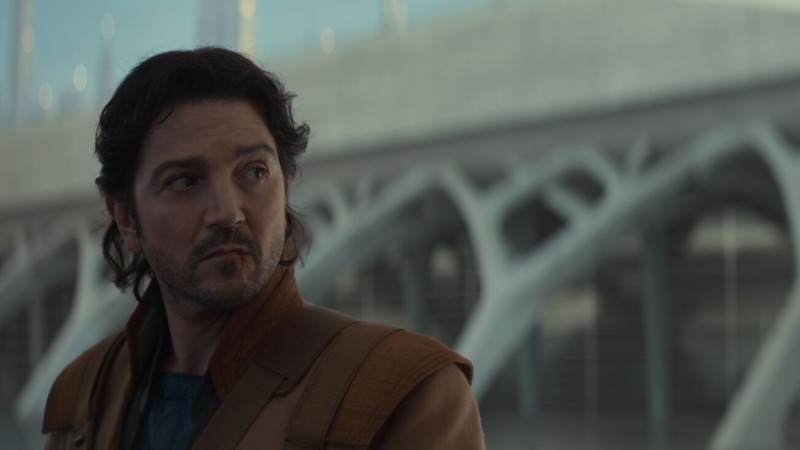Andor Was a Lesson in Self-Restraint
Photo courtesy of Disney+

When Andor was announced back in 2020 alongside nine other Star Wars TV shows, reactions were relatively muted. It didn’t follow an already beloved figure like Obi-Wan Kenobi or some of the other announced projects, and it wasn’t tackling a new time period or setting, like The Acolyte. Instead, it was going to be a prequel of a prequel following a side character from a spin-off movie.
On its face, it seemed like it another example of the series desperately searching through its existing catalogue of characters for any scraps of existing attachment, like how the entire concept of Mandalorians spun off from how nerds in the ’80s became obsessed with a cool-looking background character, who in the movie he originates from did basically nothing and then died from falling in a hole (until this was retconned so he survived to appease said fans).
Even as someone who largely enjoyed Rogue One, it seemed strange to focus an entire series around a story that seemed like it had already been told. Oh, how wrong we doubters were. Not only did Andor avoid this brand of self-referential storytelling, but it quickly proved to be one of the most incisive entries in the series period, a smart, tight, dense work that remained self-disciplined and focused on its anti-fascist themes above all else.
First off, if there’s a bar that the series immediately clears thanks to showrunner Tony Gilroy and the rest of its writers’ room, it’s how it completely sidesteps any traces of cross-over, tie-in, or “brand synergy” nonsense that increasingly defines not only Star Wars but the media landscape in general. Despite taking place only a few years before the original trilogy, household names like Han, Luke, Leia, Chewie, Lando, Vader, and nearly everyone else are nowhere to be seen.
This absence is most cleverly employed when it comes to Palpatine, simply referred to as “the Emperor,” a faceless presence who looms over Imperial meetings as mentions of his name chill the room. It’s impressive how much more imposing this master manipulator is when we don’t directly see him in all his campy, goblin-faced glory, less a cartoon evil guy doomed to be thrown into a pit, and more an impossibly dangerous Machiavellian whose machinations temporarily spread tyranny and fear throughout the galaxy.
And speaking of Force users like this Sith lord, unlike so many Star Wars stories set between the prequels and the original trilogy, we don’t meet the umpteenth Jedi who somehow avoided the Empire’s purges—in fact, this tale doesn’t feature a single lightsaber, a perfect example of its monk-like restraint. Instead, there’s a spiritual vacuum as our fledgling revolutionary, Andor, and the rest of the upstart rebellion are thrown into a duplicitous world of spy craft with no space wizards to save them. There aren’t any chosen ones, only quick decision-making that sometimes means these characters burning their own decency for a greater good.
Much like how the general absence of the Emperor makes it all the more powerful when we do get allusions towards the series’ classic symbols, this is also true when we finally get the faintest gesture at the Force, as a healer helps partially alleviate Andor’s pain from a blaster wound. The contrast between Cassian’s initial skepticism and his seeing evidence of this unexplainable phenomenon gets at what it would be like for the vast majority of people in the Star Wars universe to see unambiguous proof of Something Bigger in action, as if they are seeing water being turned into wine. It’s a moment that conjures the grandeur of what the Force is actually supposed to be, instead of a lore-oriented toolset that inspires conversations about how Force speed actually works or what’s up with Plo Koon’s Emerald Lightning ability.
This general aversion to canon-obsessed cameos and lore tie-ins is so intense that the series doesn’t even feature many characters from the story that supersedes it, Rogue One. Andor’s best buddy K-2SO doesn’t appear until the eighth episode, and when he does show up instead of getting some of Tudyk’s wonderfully dry line deliveries like in the film, we’re instead subject to the most horrific sequence of events in the entire show, as this bot quite literally aids in genocide. It’s a perfect stand-in for the series’ approach to fan service: Oh, so you wanted to see your favorite little guy from the movie? What if they were instead a literal manifestation of an Imperial death machine that commits atrocities without a second thought?
In general, the characters that do appear from elsewhere probably aren’t the ones most fans are clamoring for. Case in point, the return of the slimy Death Star director, Orson Krennic. However, this inclusion entirely works thanks to Ben Mendelsohn’s scenery-devouring performance combined with a subtle reframing of the character from the perspective of the show’s cast, as he goes from Vader and Tarkin’s pathetic underling to someone who lords over his own subordinates with sassy menace.
It speaks to how every re-appearance has a place, not as a means to appease superfans, but to serve some crucial function in the story: here, Krennic’s presence demonstrates how all up and down the chain of command, the Empire rules by fear, immediately cannibalizing its own at the first sign of weakness. Upper management appears, and shortly after, ISB officers like Dedra and Partagaz, who are as despicable as they are talented, are either dead or in prison. In short, every pre-existing character included feels there for a specific function in the story rather than just to drum up fan excitement.